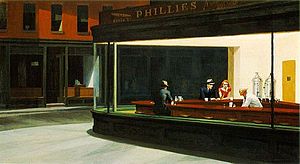Everyday American life contains an inexhaustible reservoir of new and untried subject matter~Robert Henri to his art student, Edward Hopper. (Henri was the c0-founder of the Ash Can School.)
Edward Hopper was an artist in the Realist tradition. He painted passionately the American scene that he interpreted. However, there was a dichotomy in his paintings. His images often evoked uncertainty, which was somewhat mystifying. On the one hand, he depicted deserted small towns, desolate images of urban and suburban areas, railroad tracks leading in or out of an industrial area, solitary figures in empty offices or hotel rooms. On the other hand, he would paint a lovely landscape of New England.
The same subject matter was given a more optimistic point of view by the Regionalists, Grant Wood, Thomas Hart Benton, and John Stuart Curry. As much as I admire these painters, I appreciate the emotion Edward Hopper related in his paintings.
For several years now, I’ve kept Hopper’s painting, Nighthawks, as a screen saver on my computer. I have spent much of my life traveling on business trips. Often, I would go late night to a lonely diner. I found the scene depicted in the painting to be very real. I could associate with it. I was the witness to the scene sitting with his back to the viewer. See what I mean when I say Hopper created emotion in his paintings? Isn’t that what an artist is supposed to do? He did his job and he did it well. If you really study the painting, you will note the unusual use of perspective, color, and light.
In the painting, the man with the hawk face rests his right hand on the counter holding a cigarette. His fingers nearly touching the woman’s hand. Without paying attention she seems to be deep in thought (perhaps, about some previous conversation the two had). Nonchalantly, she stares at her fingernails, seemingly inspecting them. You, the viewer, know there is more to this story. What happens next is only in your imagination. What drama! What a painting!

